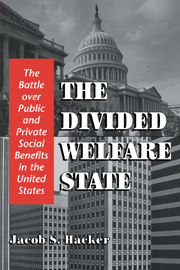Book contents
- Frontmatter
- Contents
- List of Tables
- List of Figures
- Preface
- Part I The American Welfare Regime
- Part II The Politics of Public and Private Pensions
- Part III The Politics of Public and Private Health Insurance
- Part IV The Formation and Future of the American Welfare Regime
- 6 The Formation of the American Welfare Regime
- 7 The Future of the American Welfare Regime
- Appendix
- Notes
- Index
6 - The Formation of the American Welfare Regime
Published online by Cambridge University Press: 05 June 2012
- Frontmatter
- Contents
- List of Tables
- List of Figures
- Preface
- Part I The American Welfare Regime
- Part II The Politics of Public and Private Pensions
- Part III The Politics of Public and Private Health Insurance
- Part IV The Formation and Future of the American Welfare Regime
- 6 The Formation of the American Welfare Regime
- 7 The Future of the American Welfare Regime
- Appendix
- Notes
- Index
Summary
At the dawn of a new century, many of the rallying cries of the last seem no longer to inspire Americans. Although most public social programs have survived the criticisms and strains of the past two decades, the sense once widely shared that government was capable of ameliorating the major risks and dislocations of modern life has long since faded. Faith in government has plummeted; public budgets have stabilized, even fallen; and new social programs have all but disappeared from the political agenda. And yet this “era of permanent austerity” has been accompanied by visible anxiety about evolving economic conditions that have produced both greater prosperity and greater inequality, both new wealth and new risks. For America's leaders, this has been a volatile and confusing new world, equally threatening to those who would cling to the approaches of the past and to those who would deny their continuing relevance.
Amid these uncertainties, pundits and politicians have declared the emergence of a new model of governance: a government that “rows, not steers,” that “empowers people to act for themselves,” that relies not on “top-down bureaucracies,” but on “public–private partnerships” and “market incentives.” President Bush has labeled his approach to social policy “compassionate conservatism,” vowing that government will enlist “America's armies of compassion” in the private sector to tackle social problems. The Democratic Leadership Council, the organizational arm of conservative Democrats, calls for “an enabling rather than a bureaucratic government, expanding choice for citizens, using market means to achieve public ends and encouraging civic and community institutions to play a larger role in public life.”
- Type
- Chapter
- Information
- The Divided Welfare StateThe Battle over Public and Private Social Benefits in the United States, pp. 275 - 312Publisher: Cambridge University PressPrint publication year: 2002

